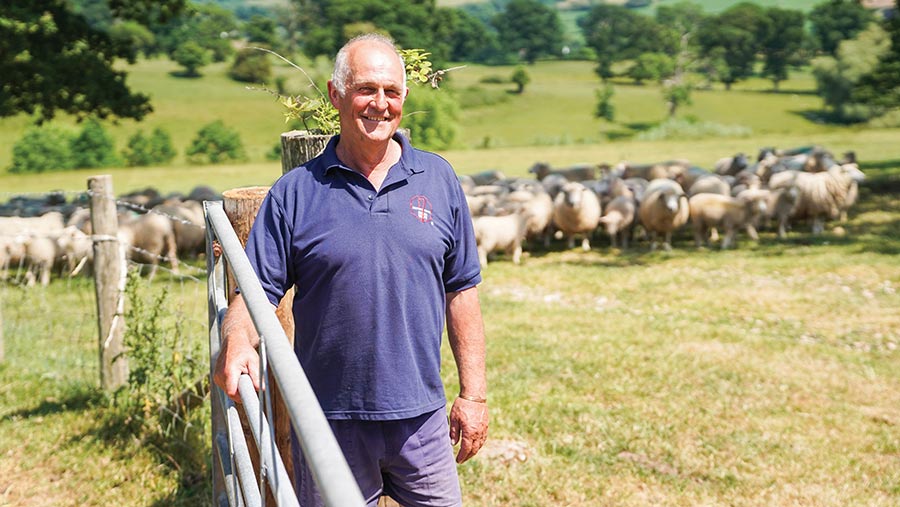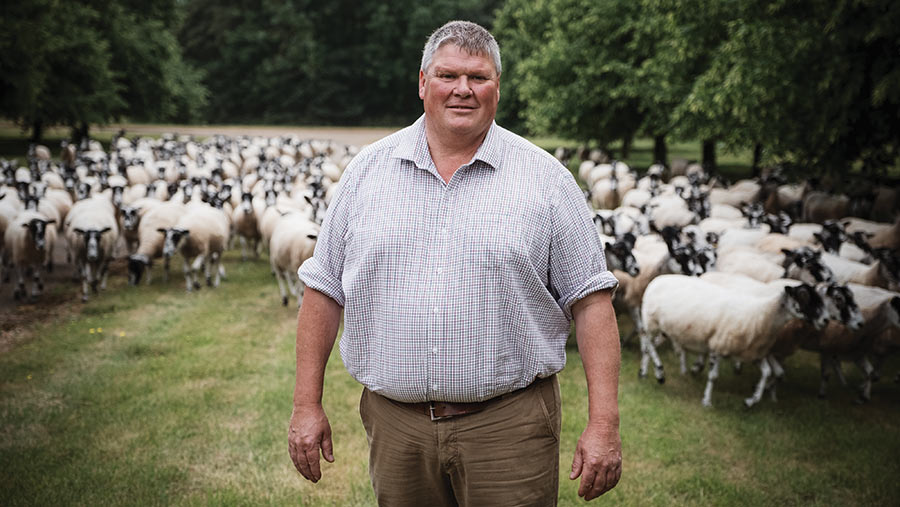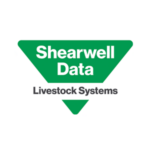Farmers Weekly Awards 2023: Sheep Farmer of the Year finalists

Tailoring working patterns, nutrition, and genetics around the constraints of landscape and staffing were strong themes this year from three sheep systems strongly focused on cost cutting.
See also: FW Awards 2023: Ag Student of the Year finalists
The judges:
The judging team visited each of the finalists for a three-hour interview and tour of their farming enterprise.
- Andy and Jen Wear, last year’s winners
- Moira Gallagher, independent judge and consultant
- Michael Priestley, Farmers Weekly reporter
The finalists:
David and Cora Cooper
Tardoes Farm, Ayrshire
Alan Derryman
Home Farm, Devon
Dan Phipps
Godolphin, Suffolk
David and Cora Cooper
Tardoes Farm, Muirkirk, Ayrshire

© Joe Somerville
Farm facts
- 3,400 Welsh Mountain and Herdwick ewes
- 700 hoggs
- 2,023ha (5,000 acres)
- 90% of farm is rough hill ground
- 1,500ha (3,706 acres) in nature agreements
- 900ha (2,224 acres) of peatland restoration
- Away wintering 1,400 lambs
- Small pure Herdwick stud flock
- Breeding females sold annually
Hardy and maternal ewes bred for low prolificacy have been an unfashionable but low-cost way to expand David and Cora Cooper’s hill farm.
David and family bought 190ha (470 acres) in Ayrshire in 2004 when the Cooper’s family farm needed to find a home for 350 ewes after grazing rights changed on Dartmoor.
Running a farm without family labour and raising three children has meant the time-strapped Coopers have needed to develop a low-input system. The result is one that leaves an 80% gross margin despite only scanning at 105-110% and rearing at 90-95%.
Profit
The system uses no fertiliser, bought-in feeds or conserved forage and lambs outdoors.
The only inputs the Herdwick and Welsh Mountain ewes get are a trace element bolus for twin-bearing ewes (which lifts weaning weights by 3kg to 28-30kg for twin-born lambs), two fluke doses, parasite control and a pasteurella vaccination.
Focusing on a low-cost system has financed land buying. The farm now covers 2,023ha (5,000 acres) after snapping up adjoining ground, creating a ring-fenced farm.
Value is added by selling 500 draft ewes annually to private buyers.
Meat from a small Badgerface Welsh Mountain flock is sold exclusively to the rare breed wholesaler MacDuffs, as well as some Welsh Mountain lambs for a pre-determined price, which helps budgeting.
About 100ha (247 acres) of better hill has been seeded using an electronic broadcaster on the quadbike to introduce white clover to the sward to fix nitrogen and increase protein production.
Away wintering 1,400-head of ewe lambs and wether hoggs near Dumfries limits autumn demand and rests grass for spring, really making the system work, explains David.
Progress
Running such a low-cost system comes with a trade-off – flock prolificacy must be controlled, and most ewes must have just one lamb.
“Our system isn’t for everyone, but it is what is right for the ground and our family,” explains Cora.
Alongside growing the flock with draft ewes, the Coopers have managed to self-replace and breed for the traits they require, cutting twinning rate from more than 30% to 14.7% this year.
More control has been brought into the system with a 50-head Herdwick stud flock, which is now used to breed stock tups for the commercial ewes.
A composite terminal sire from Logie Durno (Charollais cross Lleyn) has helped lift carcass weights from 12.5kg to 15kg over the past three years. This was done when the light lamb market looked threatened around the time of Brexit.
Meanwhile, the Coopers have erected close to 100km of fencing across the tired opencast hill ground, which has allowed rotational grazing to improve grassland productivity.
People
Having only three gathers a year (scanning, weaning/shearing and dipping) means David, Cora and farm hand Cody Gibson can manage the sheep, a holiday let, two long-term property rentals, and the fencing contracting business between them.
As 50/50 directors in the business, David and Cora ensure they engage with conservation agencies such as the RSPB and Nature Scot to get balanced and workable agri-environment arrangements on the special sites of scientific interest areas on the farm.
This approach yielded permission to manage one hill by grazing 1.2 ewes/ha, cutting black loss from 400 sheep to less than 50.
They also restored 900ha (2,224 acres) of peatland ecosystem by blocking drains, which resulted in an additional 7,500t of carbon being sequestered.
What the judges say:
A pragmatic view of what is possible within a challenging landscape and major time constraints has produced a simple and extremely low-cost system for the Coopers that is scaleable and resilient.
David and Cora Cooper summary
The judges liked
- Making inroads into decreasing mortality in outdoor system
- Very low cost, with 80% gross margin
- Improving grazing with low-input methods
- Diversified markets to minimise exposure to light lamb market
- Improved carcass with function terminal sire
- Clear focus on a simple system
The numbers
- 20 The percentage of variable costs to output
- 7,500 How many tonnes of carbon dioxide emissions have been sequestered through peatland restoration
- 3 The number of annual gathers
- 65 How many kg/ha the flock produces
- 3.1 Barren rate (%) in 2022
Alan Derryman
Home Farm, Sidbury, Devon

© Emily Fleur
Farm facts
- 250ha (617 acres) on farm business tenancy
- 900 New Zealand Romneys and 80 Stabiliser cows
- 60ha (148 acres) in arable rotation
- 20ha (49 acres) arable silage grown for cattle
- Rotation of reseeded grass, herbal leys or stubble turnips follow arable silage
A bold move to abandon a traditional breed and import foreign genetics has paid off for tenant farmer Alan Derryman, with a low-intervention flock and breeding sheep sales.
After 25 years as a shearing contractor in east Devon and several winters spent shearing in New Zealand, Alan has used his experience of other sheep systems to devise a low-intervention, organic, outdoor lambing system.
Alan moved to Home Farm on the Sidbury Manor Estate in 1996.
He has negotiated a series of 10-year farm business tenancies while switching from an indoor-lambing Mule and Suffolk Mule flock to an outdoor system lambing Romneys with 2% assistance at lambing.
Profit
It took 10 years of liming, fencing, trough installation and soil testing to get the farm set up for a forage-based sheep enterprise, using rotational grazing principles as much as possible.
In 2003, Alan switched to New Zealand Romneys, importing semen from New Zealand and using artificial insemination on the flock for three years.
He set up a six-family system and used rigorous selection pressure.
This has resulted in a low-cost flock with reasonable output, scanning at about 170% and often rearing at about 1.4 lambs a ewe.
“I was always envious of the way New Zealand sheep farmers bred animals to look after themselves,” he explains.
Margin is made by striking a balance between output and low inputs.
The bought-in feed cost last year was just 80p a ewe, comprising some pet lamb feed and organic mineral blocks.
The flock has received no bagged feed for more than 20 years.
Ewes are wintered on grass, stubble turnips and silage, and the bottom 25% of the ewes and wether lambs are finished on forage, usually requiring some rented winter keep.
The farm sells organic lambs to ABP and receives an Organic Higher Level Stewardship payment. In 2024, after 12 years in this scheme, the farm will move to Higher Tier Stewardship.
Progress
Major gains have been made improving parasite tolerance in the flock by not worming ram lambs after weaning.
Correct rams are selected from older ewes with a good history and any rams that look dirty or have a lower liveweight gain are culled out and fattened.
“We can save at least one wormer a year now on where we were when we started,” explains Alan.
Despite a lack of marketing, he has been selling breeding stock on the back of his culling policy and system for the past 10-15 years.
Surplus ewe lambs and about 25 shearling rams are sold privately with maedi visna accreditation.
This year, 140 out of 240 ewe lambs were tupped and lambed to drive down carbon footprint and increase flock productivity.
Meanwhile, suckler cows were added in 2007 and graded up to Stabilisers in 2010, selling bulls as part of the Stabiliser Cattle Company.
People
Alan and partner Gwenan do all the sheep work, with a self-employed hand coming in four to five days a week for routine seasonal jobs.
“We delegate responsibilities so people feel part of the farm,” explains Alan. “This is so jobs can be done independently, but they can report back to us when there are issues.”
Flock genetics mean very few problems arise with feet, and the main management gatherings are sufficient to run the flock through the year.
What the judges say:
Alan’s vision and endeavour has developed a low-cost system around forage production. Strict culling policies and high expectations of what a commercial ewe should achieve have resulted in ram sales.
Alan Derryman summary
The judges liked
- Low cost with added value of organic certification
- Clear view of what a commercial sheep must do for a commercial farmer
- Travelled, worked near and far and applied lessons learned
- Marries payments up to help improve infrastructure and support low-cost system
The numbers
- 2% Assistance at lambing
- 65% Average twinning rate
- <5% Proportion of ewes with triplets
- 25 How many shearling rams are sold annually
- 80p Concentrate cost per ewe last year
Dan Phipps
Godolphin, Newmarket, Suffolk

© MAG/Colin Miller
Farm facts
- 1,850 breeding ewes and 470 shearlings
- Mostly North of England Mules
- Ewes wintered on 16ha (40 acres) of fodder beet
- Beltex-Texel cross-breds, Suffolk and Charollais rams used
- 1,011ha (2,500 acres) of post and rail paddocks
- 485ha (1,200 acres) of training ground
- 1,618ha (4000-acre) arable estate
- Most lambs sold to Pilgrims Lamb UK and heavy lambs sold to local butcher
Good working relationships and efficient sheep management have seen Dan Phipps treble the sheep he manages for a leading racehorse stud.
Dan was a shepherd for three large store-lamb finishers after moving to East Anglia in 1990, and soon started co-operating with studs, using sheep as a grassland management tool.
He was hired as a self-employed shepherd to run 650 ewes for Godolphin Stables in 2002.
This became a full-time job in 2006 when the flock was increased to 1,800.
Collaborating with stud director Liam O’Rourke and 15 stud managers has allowed Dan to work the sheep around the horses, making the most of the herb-rich paddocks the horses graze.
Pragmatism and stockmanship are needed to run sheep across extensive and outlying areas, and the job often involves travelling 15-20 miles a day. There is very little field-to-field rotation of ewes.
Profit
Margin is based on achieving high output, as a lot of transport and labour costs are unavoidable.
Early lambing indoors on straw is employed to maximise lamb values, which this spring peaked at £7.60/kg deadweight.
However, only January lambs (1,750) are creep-fed from the first week and weaned at 10-11 weeks old. February-born lambs (1,000) are weaned onto red clover and ryegrass and finished on forage.
Sheep lamb for 2.5 cycles from 17 January inside on straw and a ration based on clover haylage, barring 125 late lambers that lamb outside in May.
Flock output has hit 162-174% reared, with 7.4-13.3% mortality over the past four years.
This is achieved with about 1,200 Mules, bought from Lazonby’s Alston Moor sale, and 600-700 retained cross-bred ewes, which are served by Charollais rams.
This performance helps boost lamb cheques. The first 2,474 lambs sent to Pilgrims last year graded 95% R-grade or better and 25% hit a U or E grade.
Despite the logistical challenges, the business reported 92% in-specification at an average of 20.05kg deadweight, returning £126.92 a lamb.
Progress
Several time-saving alterations have been made over the years.
One major improvement was a lambing shed, built in 2008. Capable of housing 500 ewes, it typically contains 300 triplets and singles, with room for 100 individual lambing pens.
A drainpipe trough system saves time by supplying the individual pens in the lambing shed.
Next door, a large cattle shed is also used for twin-carrying ewes in good condition, which typically need less assistance and checks. About 80 individual pens are placed here as fewer complications are expected.
Elsewhere, watering is made easier by ensuring 300-litre tanks are plumbed into the mains, so staff always have fresh water within 7-8m.
People
Dan works alongside his son, Tom, and Andy Armer, who are the full-time staff. This allows Dan to hold the role of National Sheep Association chairman.
Two extra labour units are hired in for six weeks at lambing – one day- and one night-lamber.
Shepherds and machinery staff are all in regular contract through a WhatsApp group and a morning meeting is held between Dan, Andy and machinery manager Gary Gilbert to adapt sheep management around horse grazing plans, which the team can see on AgriWebb.
Independent sheep consultant Kate Phillips advises on metabolic profiles, forage analysis and health management, producing an annual costing and performance report. Godolphin calculates a budget for the sheep enterprise each year.
What the judges say:
A range of managerial, stockmanship and land stewardship skills have seen Dan Phipps balance the needs of an elite horseracing stud alongside a high-output sheep flock, controlling costs in the process.
Dan Phipps summary
The judges liked
- Adoption of software to help staff autonomy
- Strong communication skills
- Added value to heavier carcasses
- Development of an adaptable system to fit round horses
- Use of arable ground to minimise wintering cost
The numbers
- 168% How many lambs have been reared as an average over the past four years
- £106.10 Average gross margin per ewe in 2022, down from £112.60 in 2021
- 10.7% Average total losses from scanning to sale for the past four years
- 10.23 Average metabolisable energy level (MJ/kg dry matter) of clover silage last year
- 15 How many stud bosses the team need to work with
Sheep Farmer of the Year 2023 is sponsored by Shearwell Data
Sponsor’s message
 “Congratulations to the Sheep Farmer of the Year finalists. They all demonstrate an adaptable, progressive and innovative approach to their farming businesses. Shearwell Data is committed to supporting British farmers.
“Congratulations to the Sheep Farmer of the Year finalists. They all demonstrate an adaptable, progressive and innovative approach to their farming businesses. Shearwell Data is committed to supporting British farmers.
Richard Webber, director, Shearwell Data
